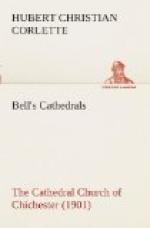#John of Clymping# (1253-1262) succeeded Richard. His episcopate appears chiefly remarkable for the growth of stories about the miraculous powers and saintly life of his predecessor.
#Stephen of Berghsted# (1262-1288) now occupied the see. During his episcopate Richard was canonised, a deputation, sent at great cost to Rome, having succeeded in persuading Urban IV. that his merits and fame deserved an honour which should bring wealth and celebrity to the see in whose cathedral his body was laid; so in 1276 the remains of his body were removed from their tomb and placed at the back of the high altar in a shrine, or feretory, dedicated to him.
[Illustration: TOMB ASSIGNED TO BISHOP RICHARD OF WYCH, AND PICTURES ORIGINALLY BY BERNARDI. Photochrom Co. Ltd., photo.]
#Gilbert de Sancto Leophardo# (1288-1305) was a bishop who, like S. Richard, devoted himself to his diocesan duties with a singleminded purpose which was not a common virtue with all mediaeval prelates. He endeavoured to regulate the habits of those clergy who accepted their privileges but were inclined to neglect the duties and responsibilities these involved. His interest in the fabric of the cathedral was expressed principally by the additions that were made to the lady-chapel during his episcopate.
#John Langton# (1305-1337) took a conspicuous part in the suppression of the knights templars during the reign of Edward II. in obedience to the papal order regarding them. He was Chancellor of the Realm before his elevation to the episcopate, and showed his energy as a statesman locally by commanding the restoration of rights to some vicars of the cathedral who had been suspended in accordance with the provisions of certain statutes which the dean and chapter made without his consent. Like Bishop Gilbert, he was an instrument by whose sanction more changes were made in the building.
#Robert of Stratford# (1337-1362), another statesman bishop, succeeded Langton. He had also been chancellor, and asserted his episcopal authority as sternly as his predecessor.
Of #William of Lynn# (1362-1368) and his episcopacy little record remains; but




